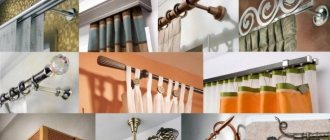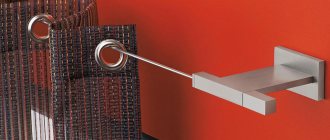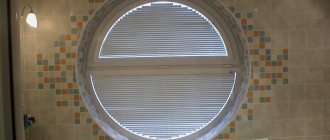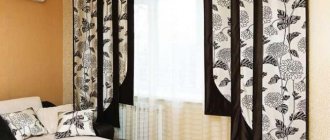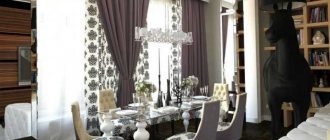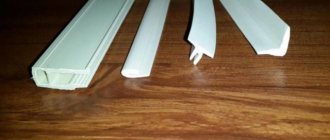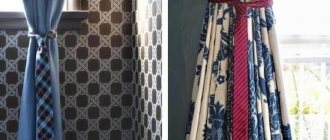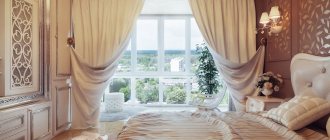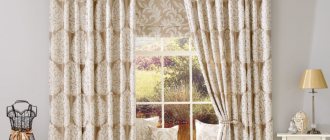In recent years, new technologies based on asymmetrical balance have been introduced into interior design. This design involves the use of windows with bay, arched or curved frames. The design of complex openings is best done using a flexible ceiling curtain rod - an elastic ribbon structure that can take different shapes depending on the interior design of the room.
Living room with a trapezoidal window structure, decorated with a flexible cornice, which solves the problem of a non-standard window
Description and characteristics of flexible curtain rods: advantages and disadvantages
A flexible cornice is used in cases where it is not possible to use traditional cornices to attach curtains.
The length of the cornice is 6 meters. The flexible tape can be cut crosswise to the desired size. This will not affect the technical characteristics or appearance of the fastening system.
Flexible cornice kit
- Profile.
- Calipers that fix the crossbar in the required position.
- Plugs used to secure the edges of the base.
- Brackets that regulate the distance between the cornice and the wall.
- Hooks for hanging curtains (lower ones for light curtains and upper ones for heavy curtains).
Standard equipment of aluminum flexible curtain rod
Some models come with extensions that allow you to extend the base of the system if necessary.
Flexible curtain rod has the following advantages:
- presentable appearance;
- ease of installation;
- affordable price;
- compact dimensions;
- ease of sliding curtains along the guides.
However, in small rooms, these fastening systems will take up too much space, visually reducing the space of the room, and when decorating small window openings, such designs will look too pretentious.
Metal double-row cornice
A double-row metal ceiling cornice is a rather interesting option for decorating a living space. In this case, you can use the classic model or give preference to mini metal products.
If during the purchase process you choose reinforced cornices made of metal, then such models will be able to withstand quite heavy canvases during operation. Metal structures are excellent for curtains made of velvet, brocade or chenille.
Thanks to the wide product range, you can find ceiling cornices on sale that differ in shape, color, size, and the presence of decorative elements. As a result, everyone will be able to choose the option that best suits their style.
Ceiling aluminum double-row cornice
Ceiling aluminum double-row cornices are an excellent option if you need to install them in special niches. If this option is compared with models made of plastic, it is worth noting that aluminum structures do not require special maintenance and operate flawlessly throughout their entire service life.
If we consider the technical characteristics, then in this case the following points can be noted:
- Best used for light fabrics;
- the length of the product can reach a maximum of 6 m;
- it is possible to join elements;
- A distance of 3 cm must be maintained between the lines.
In this case, the fastening is carried out to the ceiling surface.
Wall-mounted aluminum double-row cornice
The most popular method of attaching profile aluminum double-row cornices at all times is the wall method. A feature of the wall mounting method is the ease of installation work. Aluminum curtain rods with wall mounting are great for narrow rooms that have fairly high ceilings. This choice is due to the fact that the aluminum double-row cornice will be located from one wall of the room to the other, as a result of which it is possible to visually enlarge and expand the room.
Metal double-row cornices: photos in the interior
To understand exactly what a metal cornice looks like in interior design, you can look at the photo.
How to attach a flexible cornice?
Instructions for self-assembly and installation of ceiling cornice
Installation of flexible curtains is carried out according to this algorithm.
- Places for installing the profile are marked on the wall or ceiling.
- For holders, holes are drilled with a hammer drill at a distance of at least 50 cm.
- The calipers are fixed using self-tapping screws or dowel-nails.
We install the brackets on the ceiling and determine the length of the cornice - Roller runners are placed on the profile.
- The cornice is snapped onto the brackets, cutting off the excess length.
- The ends of the profile are covered with side plugs.
- Curtains and tulle are attached to the cornice using hooks.
We insert the cornices into the profile into the brackets, put on the runner rollers and close the ends
This design should only be mounted on a rough ceiling, because plasterboard and suspended ceilings cannot withstand the weight of the fastening system and curtains.
If the flexible profile will only be used for light tulle curtains, it can simply be glued on.
High-quality curtain rods bend easily at any angle. If difficulties arise with a PVC profile, it is heated with an electric hair dryer, since warm plastic becomes more pliable. Heating is carried out sequentially: individual parts are heated, immediately giving them the desired shape.
Recommendations for installing curtain rods
The installation of a finishing structure must be taken with full responsibility. To install it you will need dowels and screws. Tension cornices do not allow errors in installation calculations. Installation work on installing ceiling structures is fundamentally different from installing wall cornices, which are secured with clamps and brackets.
To install ceiling cornices, self-tapping screws are used, which should be located 60 cm from each other. To strengthen a soft plastic product, tin or hard plastic washers are used. If the curtains and curtains are not heavy, then you can use “liquid nails” in the fastening method. Before performing work, you need to carefully prepare the base, clean it of dust and thoroughly prime it. In order for the adhesive seam to be strong, “liquid nails” must have a tensile strength of 80 kg/cm.
Tools and accessories for installation work:
- electric drill;
- 2 drills of different diameters;
- fastening device;
- knife, file or jigsaw;
- tape measure, pencil and square.
Fastening devices are installed at least two meters apart. Their use depends on the structure of the ceiling. For concrete and brick ceilings, Pobedit drills are used. Before installing the structure, you need to assemble it. It is better to do this on a flat floor. To prevent the hooks from falling off the product, you need to secure them with plugs.
In order for installation work to proceed easily and quickly, you need to carefully make your choice of product and its purchase, check the availability of all components and specify its length.
The installation work for installing the ceiling structure is simple. Even a non-professional can do this work independently.
Flexible curtain rod options
Types of flexible curtain rods made of different materials and different shapes
Depending on the type of fastening, flexible curtains for curtains are divided into:
- ceiling;
- wall-mounted
It is advisable to use ceiling profiles in small rooms with low ceilings. By attaching light transparent curtains to such a model, you can visually enlarge the room. These fastening systems mask defects in window openings well. They are also used to decorate doors in the shape of an arch, install a canopy or screen in the bedroom.
A curved flexible ceiling curtain rod is a modern solution for decorating a window opening that does not have a standard shape.
Wall structures are used to decorate arches or windows with a rounded arch. In this case, the base is installed on holders fixed to the wall.
Wall-mounted flexible cornice for a bay window in the dining room interior
Depending on the shape, the cornices are:
- straight;
- corner.
Corner flexible cornice is used for rooms with windows on two sides and allows you to create a single composition
Straight models are universal in use, while arched ones are designed for bay and roof windows, as well as for zoning rooms.
Flexible curtain rod bending options for a harmonious interior
What are cornices?
A curtain rod is a holder for curtains, the design of which includes the guides themselves, brackets for mounting to the base, various types of fastenings for curtains, as well as decorative elements. Cornices, also called consoles or baguettes, are important in a functional and decorative sense.
Curtain consoles must:
- be able to withstand the weight of suspended curtains for a long period of time;
- do not interfere in any way with the opening or closing of curtains;
- do not stray from the style of the room, decorate and complement the interior.
Cornices can be attached to the walls or directly to the ceiling. Each of these options has its own advantages and disadvantages.
Interesting examples in the interior
Decorative semicircular systems will advantageously emphasize the architecture of an unusual room
The most common area of application for flexible curtain rods is decorating windows in the living room. Sometimes the profile is decorated with LED lighting to create contour lighting around the perimeter of the room.
Flexible ceiling cornice for room zoning
In addition, elastic fastening systems are used for the following purposes.
- Zoning the space of the room
The design allows you to divide the total area of the room into separate parts (for work, rest, study).
Using a flexible cornice to divide and zone a room
- Creating screens or canopies over the bed
A profile with curtains above the berth provides protection from drafts, bright sunlight, and harmful insects.
Flexible cornice for attaching a canopy over a bed in a child's room for a girl
- Bathroom curtain mounts
A cornice installed in a bathroom is used to zone a combined bathroom or to separate the bath from the rest of the room. This technique is relevant for bathtubs that have a corner, semicircular or round shape.
Flexible curtain rod for the bathroom, zones a combined bathroom or separates the bath itself from the rest of the room
- Bay window decorations
Semicircular and round curtains for curtains, mounted on bay windows, balance the proportions of the room and help create an atmosphere of special comfort in the room.
For decorating a bay window, the most convenient design option is a flexible ceiling cornice
Such widespread use of cornices is due to their small size. The designs are almost invisible in the interior, so attention is focused on the curtains or curtains.
To decorate arches and various doorways, a flexible arched cornice made of polyurethane is used
A flexible ceiling cornice is a multifunctional fastening system that, if necessary, can be bent in any direction and at any angle.
Flexible ceiling cornice - an original and simple installation for decorating window curtains
Such structures are made of aluminum and PVC. Both options are practical, however, metal models are capable of holding heavy multi-layer curtains, while plastic ones are used for light curtains and various decor.
Installation of elastic profiles is quite simple: markings are made on the surface for the main fastening points, and then the structure is fixed on the brackets.
Curved cornices are used to decorate window and door openings, highlight separate zones in a room, hang curtains in the bathroom, and create a canopy over a bed.
Flexible cornice is perfect for decorating an arched window
Tire double-row cornice
The double-row ceiling bus has a large number of advantages compared to other models. Thus, tire models are considered unique designs that can decorate any living space:
- due to the fact that high-quality material is used in the production process, this significantly increases the service life;
- There is a wide range of products, as a result of which you can choose a model to suit any style;
- a distinctive feature is a high level of strength, which allows you to attach curtains of any weight;
- reasonable cost, thanks to which everyone can afford tire models;
- Anyone can carry out installation work, even without proper experience in this field.
It is important to take into account the fact that if used incorrectly, the structure may break.
Important! This option can even be installed on a suspended ceiling.
Photo gallery of flexible curtain rods of different types in the interior:
PreviousCurtainsAbout light-proof Blackout roller blinds: what are they, how to choose?
Next
CurtainsTypes of roller blinds for plastic windows by type of fastening
The difference between curtains and cornices
To dot all the i's, it is worth paying attention to the correct understanding of these words. Many people confuse these two concepts and believe that curtains are hung on ceiling curtains, and the street projection of a window is called a cornice. This is a misconception, let's look at the dictionary.
The word "curtain" translated from German means curtain. In the Russian dictionary, a curtain is a wide and long sheet of light fabric that covers the window all the way to the floor. Such curtains can independently decorate a window or act as an additional layer for curtains.
Previously, the cornice was the protrusion of a building on the street, which was located under the slope of the roof or on top of the window. Nowadays, a cornice is a device above a window inside a room, necessary for holding curtains and curtains.
Remember, ceiling curtains are curtains, and a cornice is a device for curtains.
Now you will be attentive to these words during pronunciation, understanding the meaning of what was said.
Types of ceiling cornices
When choosing a method for attaching a cornice, take into account the structural features of the room and the desired decorative effect. For example, in wall structures it is necessary to have reliable walls and a significant distance between the window opening and the ceiling. For ceiling structures, a strong base of the upper surface is important.
When deciding on a cornice, first of all, take into account the following important characteristics of consoles related to:
- The dimensions of the room and in particular the width of the walls. Plan the dimensions of the installation, calculate how much wider the ceiling cornice will be than the window opening, or maybe you want to hang curtains along the wall from corner to corner?
- features of the curtain model;
- ceiling configuration;
- general stylistic orientation in interior design.
The dimensions, strength and type of curtain rod always correspond to the weight and size of the selected curtains. There are three basic types designed for:
- light fabrics;
- medium in weight;
- heavy and massive curtains.
The load that the cornice can withstand is directly related to the structure’s fastening system and the material of manufacture. For example, a string cornice is designed for light fabrics such as tulle and organza. A massive wooden or metal model is suitable for dense fabrics in several tiers, including swags and lambrequins.
According to the profile level, the cornice can be:
- single-row;
- double row;
- three-row.
The following is a classification according to the material used to make the structures:
- plastic;
- aluminum;
- metal;
- wooden.
Hidden ceiling cornice
This option involves a ceiling cornice hidden in a niche for suspended ceilings. The photos in the article demonstrate a rather interesting design effect, when the curtains seem to descend directly from the ceiling. For such installation, the cornice should be purchased in advance and fixed directly to the ceiling. Then in front of it, at a distance of several millimeters, a wooden beam profile is attached, which will serve as a guide for the design of the tension structure. It is worth considering that this method will slightly reduce the area of the stretch ceiling.
Polyurethane ceiling cornice
Polyurethane is a universal material for realizing various design fantasies. Thanks to its flexibility, it is perfect for decorating arches, bay windows and other non-standard architectural configurations. A polyurethane ceiling cornice, in addition to its main purpose as a textile holder, can serve as an excellent decorative element - it has a wide variety of reliefs, and the surface can be repeatedly repainted in different colors.
